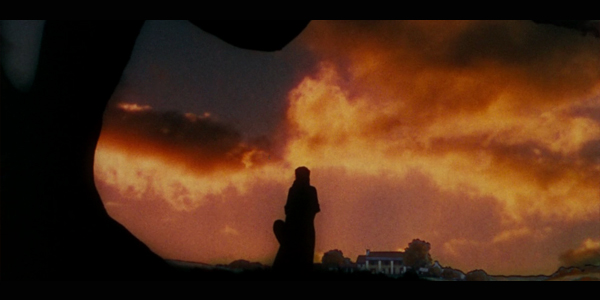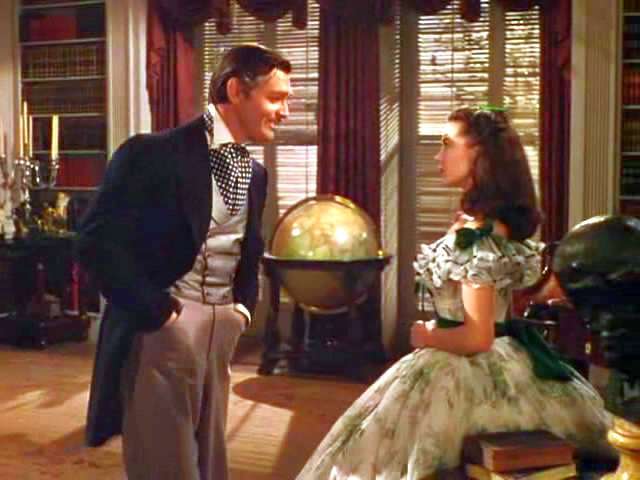1939 is often remembered as the best year in cinema,
as during this one year numerous classics including Ninotchka,
Stagecoach, Mr. Smith Goes to Washington, and The Wizard of Oz were released. Despite the fine quality of these
films, however, one production eclipsed them all; MGM’s adaptation of Margaret
Mitchell’s epic tale of life and love during the American Civil War, Gone With the Wind. It has been seventy
five years since iron-willed Scarlett O’Hara first appeared on screen, and in
that time her struggle to not only survive, but thrive in a world that has
exploded beneath her has only become more mesmerizing. Here are just five of
the countless reasons to celebrate seventy-five years of Gone With the Wind in all of its romance, excitement, heartbreak,
and ultimately its glory.
1. CHARACTER
DEVELOPMENT: Chronicling twelve years in the life of Scarlett O’Hara against the
backdrop of the Civil War and Reconstruction, Gone With the Wind is truly epic in scope. While its four hour
running time may seem redundant, the film manages to keep viewers on the edge
of their seats through every minute of it. This ability to entertain is largely
due to the way in which it accurately portrays the growth and development of each
of its characters in response to the turbulent times in which they are living.
The most startling changes take place within its central heroine as Scarlett
seamlessly evolves from a fiery but sheltered plantation belle, to the
embittered but resourceful head of her struggling family, to a successful but
ruthless businesswoman. While such drastic changes might have come across as
false or forced in another film, the script’s writers portray the drastic
experiences that mold its characters with such honesty and nuance that
Scarlett’s transformation is only logical. Similarly, her roguish suitor, Rhett
Butler, slowly reveals himself to be far more decent than the gentlemen who
scorn him as he risks his life to transport Scarlett and her sister in law,
Melanie, out of a burning Atlanta and proves himself to be a far more devoted
husband and father than even Scarlett thought him capable of. Even the film’s
supporting characters face a number of changes as delicate Melanie acquires a
quiet strength and dreamy Ashley is finally forced to face reality after returning home from war to a world that no longer has a place for him. Through
its portrayal of real people living in all too real hardships, the film ensures
that audiences understand and care about each and every member of its massive
cast from its opening in the twilight of plantation living to the aftermath of
war and occupation.
2. SIGHTS
AND SOUNDS: One of the first things that any viewer will notice when watching Gone With the Wind is the skill with
which it was produced. Despite its 1939 release, the film’s visual and sound
effects remain nothing short of stunning. The sets are rendered with such
detail that it is shocking to realize that the rolling fields of Tara, bustling
streets of Atlanta, and battered remains of the Civil War were not filmed in
Georgia, or anywhere in the south but actually on a series of studio lots. The
period costumes are also impeccably accurate and highlight the stark changes in
the character’s circumstances better than any dialogue could. Scarlett’s costumes
were such stand-outs that her dresses (a certain curtain comes to mind) remain
staples of fashion inspiration and pop culture reference. The dazzling
Technicolor that the film was shot in brings the long since vanished world of
the Old South to vibrant life, leaving viewers with the sense that they have actually
been transported back in time to this critical juncture in history. Max
Steiner’s lilting score is nothing short of iconic and provides an emotional soundtrack
to the film’s proceedings. In particular, his “Tara’s Theme” remains one of the
most recognizable themes to ever come from a cinema speaker through its ability to
evoke nostalgia, struggle, and ultimately triumph in its notes.
3. HISTORICAL
SIGNIFICANCE: The success of the film can be measured in as many terms as there
are members of its cast. The film won a total of ten Academy Awards with Best
Actress and Best Actor Oscars going to stars Vivien Leigh and Clark Gable and
the picture earned that most coveted of awards, Best Picture. Hattie McDaniel’s
Oscar win for her by turns comical and heartfelt portrayal of O’Hara family
slave turned devoted family confidant, Mammy, marked the first time that an
African American took home the gold statue and began the process of breaking
down the racial barriers that dominated Hollywood. Even after seventy-five
years of passing trends and new blockbusters, the film maintains the title of all
time highest ticket sales and top grossing film of all time when adjusted for
inflation, a fact that is particularly daunting when considering the limits of
marketing campaigns and consumer resources during the Great Depression.
4. REALISTIC
ROMANCE: One of the most memorable aspects of the film is the timelessness of
the romance between Scarlett and Rhett. While many films idealize romance as a
pure thing that effortlessly conquers all, Gone
With the Wind reminded its audience of the complexity and brutality that
love all too often encompasses. Rather than coming together through a
convenient meeting and instant attraction, these startlingly modern lovers
fight, struggle, and endure their way to love. The early banter between the two
reveals that each is more intelligent and complex than they present themselves
as to the outside world, and more importantly that each is able to see those
qualities in the other. Despite her two previous marriages and his many amorous
exploits, neither can fully be themselves except when they are together. It is
only in Rhett’s presence that Scarlett is able to show both the vulnerability
that she is careful to hide and the shrewdness that society forbids ‘decent’
women. Similarly, it is only with Scarlett that Rhett is willing to put aside
his cynical persona and reveal his true sentiments. While there is no
denying the attraction between them, however, neither Scarlett nor Rhett is
able to let down their guard long enough to reveal the true extent of their
feelings to each other. Although their vicious cycle of each wanting the other
but lashing out instead of showing it can be frustrating, it is also incredibly
realistic. In movies and books love triumphs, but in life it is only as strong
as the people who feel it and their courage to reveal it. In real life people
feel fear, insecurity, and pride just as strongly if not more so than love, and
it is all too often those feelings that drive our actions. Even after, or
perhaps because, they have survived war, occupation, poverty, and personal
loss, Rhett and Scarlett are too frightened of the possibility of rejection to
allow themselves to come to terms with the acceptance that is actually right in
front of them. While it might not be the stuff that dreams are made of Scarlett
and Rhett’s romance is one that is based more in reality than such romantic favorites as Titanic, The Notebook, or even Casablanca.
5. MORE
THAN JUST A LOVE STORY: Despite the enduring power of the tragic love between
its leads, Gone With the Wind is far
more than a mere love story. Instead, it is the story of a place and its
people; of those who go under when the world around them collapses and those who
press on at any cost. The story relates more than the struggles of Scarlett
O’Hara, although that alone would have made enough for a best-selling novel.
Through Scarlett’s devastating lows and soaring highs viewers are witness to
the leisure and hypocrisy of life in the Old South, the devastation of the
Civil War both on and off the battle field, and the deprivations of
Reconstruction. Following the novel’s release, it became a coveted, and often
illegal, best-seller in Nazi occupied Europe and later in Soviet controlled
Eastern Europe, war-torn Vietnam, and finally presently oppressed North Korea.
As diverse as those societies seem, they all have two things in common; they
have known the horrors of oppression in one form or another and their people
still refuse to give up on hope for another day. It ultimately this same
universality and timelessness that has made Gone
With the Wind one of the most iconic and successful films world-wide. Coming
of age tale, war story, family saga, historical epic, and so much more are
encompassed in the four syllables Gone
With the Wind.
 |
| After all tomorrow is another day! |



Wow, I never realized how much there actually was to "Gone with the Wind". I mean I knew about the impact the film had on Visual and Sound Effects, but not any of the other stuff. It opened my eyes (in a way) to look at this film from an entirely different perspective (I'm surprised some people in the 75 years that this film has existed haven't pointed out some of the more apparent parts that you did)
ReplyDeleteSo glad you enjoyed it! I have to say this one has gotten me through some rough times for all those reasons, and I just wish more people would give it a chance instead of writing it off as a chick flick when its anything but.
ReplyDeleteI think the 4-Hour runtime is what really puts most audience off. it was written and created during a time when people could use/needed a 4 hour distraction from their lives, it was a perfect outlet to forget their troubles, take in some old culture, and be entertained. I know for me personally sitting through a film over 2 hours (unless the story manages to grip me) is quite difficult.
Delete